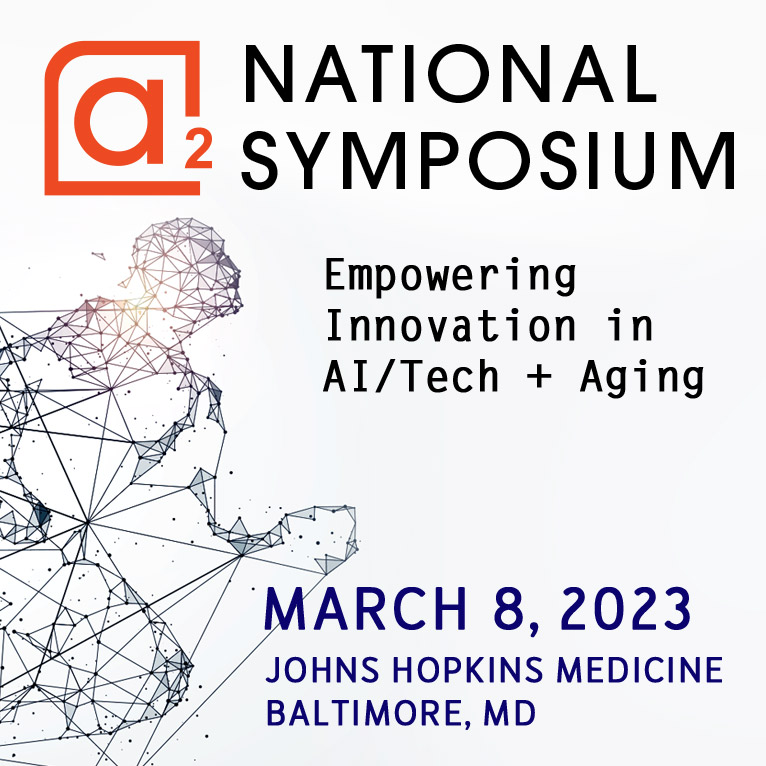The third annual a2 Pilot Awards competition for AI and technology development projects seeking to improve older adults’ health and quality of life opens on May 1, 2023. Applications will be accepted until 5 p.m. ET on July 31, 2023. Learn more and apply here.
Over the past decade, artificial intelligence (AI) has increasingly been applied to meet needs in fields ranging from education to engineering to health care. As the pace of AI innovation accelerates, more fields are turning to AI as a source of versatile solutions to longstanding challenges.
A topic of particular interest is AI’s potential to address aging-related concerns. The population of adults aged 60 years and older is projected to double worldwide between 2020 and 2050. Correspondingly, by 2050, the number of individuals in the United States living with dementia will more than double; it will more than triple globally.1,2 The American Geriatrics Society projects that the number of practicing geriatricians in the United States cannot rise to meet this demand.3 Thus, increasing opportunities will emerge for AI-assisted devices to augment the workforce that is needed to care for persons with dementia.
An alternative approach to assess the potential opportunities for AI to enhance dementia care follows from an informal analysis of recent MEDLINE publications. The amount of ongoing research in the areas of AI and dementia can be roughly estimated by taking into consideration the number of yearly publications indexed in the National Library of Medicine’s MEDLINE database. Yearly publication records reveal an increasing allocation of resources to both AI and dementia oriented biomedical research (see Figures 1 and 2 below).4 However, in 2022, publications at the intersection of AI and dementia comprised only 2.7 percent of total dementia-related publications and only 1.25 percent of total AI-related publications.
Developing AI applications to address the healthcare needs of individuals with dementia is difficult. Doing so requires multidisciplinary expertise and cross-disciplinary collaborations, as well as the ability to address challenges related to usability, ethics, and equity when designing, implementing, and evaluating aging-related AI applications.5 Initiatives that foster collaboration among AI and dementia researchers, facilitate the adaptation of existing technologies for applications in dementia, and promote the integration of older adult populations into the design and validation of AI algorithms and products can help enhance alignment between these two fields and augment the share of AI research devoted to the increasingly urgent challenges of dementia.
Although analysis of PubMed literature trajectories for the fields of AI and dementia research indicates that these fields are growing rapidly on an individual and combined basis, further integration of the two fields is needed to ensure that the increasing momentum of innovation in AI can be optimally leveraged to stimulate progress in dementia research. The National Institute on Aging (NIA), a part of the National Institutes of Health (NIH), funded the a2 Collective to encourage universities, commercial startups, and the technology sector to work together to innovate commercially viable AI- and technology-enhanced approaches to aging. The annual a2 Pilot Awards competition aims to speed this integration by amplifying synergies across the field of aging research and the technology sector and helping to match aging-related challenges with AI- and technology-driven solutions.
The a2 Collective’s focus on fostering collaborations to leverage AI to improve older adults’ health and quality of life is complemented by other federal initiatives established to advance AI applications in healthcare and biomedical research. The National Science Foundation has invested $220 million to establish 18 National AI Research Institutes focused on AI-based technologies to bring about advances in a range of sectors, including health care. One such center, the AI Institute for Collaborative Assistance and Responsive Interaction for Networked Groups (AI-CARING), is led by the Georgia Institute of Technology to support a growing population of older adults by developing AI systems that help to sustain independence, improve quality of life, and increase effectiveness of care coordination across the care network. Additional AI-driven initiatives supported by NIH, such as the Bridge to Artificial Intelligence (Bridge2AI) program and the Artificial Intelligence/Machine Learning Consortium to Advance Health Equity and Researcher Diversity (AIM-AHEAD), focus on promoting implementable, accessible, and equitable AI for biomedical and behavioral research.
Individuals, institutions, and commercial ventures interested in joining the a2 Collective in leveraging AI and technology to shape the future of aging are encouraged to apply to the third annual a2 Pilot Awards competition. Applications will be accepted from May 1 to July 31, 2023, and an informational webinar for prospective applicants will be held at 12 p.m. ET on Monday, June 5. Learn more and read the full request for applications here.
The a2 Collective is funded through NIA grants U24AG073094, P30AG073104, P30AG073105, and P30AG073107.


Figure 1 is a line graph of the number of publications from 2000 to 2022 returned for each query. However, because the number of articles returned for the Medical Subject Headings (MeSH) query “Dementia” AND “Artificial Intelligence” was much lower compared to the other queries, the figure cannot sufficiently display all data. Instead, in Figure 2, the number of articles is represented using a logarithmic scale to display a much larger range of data. This scale begins at log(0), which is equal to 1, and increases by logarithmic values, allowing all three publication trajectories to be represented on the same axis.
References
1. Word Health Organization (2022). Ageing and health. https://www.who.int/news-room/fact-sheets/detail/ageing-and-health#:~:text=By%202050%2C%20the%20world's%20population,2050%20to%20reach%20426%20million
2. GBD 2019 Dementia Forecasting Collaborators (2022). Estimation of the global prevalence of dementia in 2019 and forecasted prevalence in 2050: an analysis for the Global Burden of Disease Study 2019. The Lancet Public Health, 7(2), e105-e125. https://doi.org/10.1016/S2468-2667(21)00249-8
3. American Geriatrics Society (2022). Geriatrics Workforce by the Numbers. https://www.americangeriatrics.org/geriatrics-profession/about-geriatrics/geriatrics-workforce-numbers
4. The PubMed search queries used included: (“Dementia”[Mesh]); (“Artificial Intelligence”[Mesh]); (“Dementia”[Mesh] AND “Artificial Intelligence”[Mesh]). Publication records were downloaded from PubMed on January 20, 2023.
5. Berridge, C. & Grigorovich, A. (2022). Algorithmic Harms and Digital Ageism in the Use of Surveillance Technologies in Nursing Homes. Front Sociol 7(957246). https://doi.org/10.3389/fsoc.2022.957246




